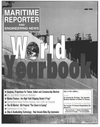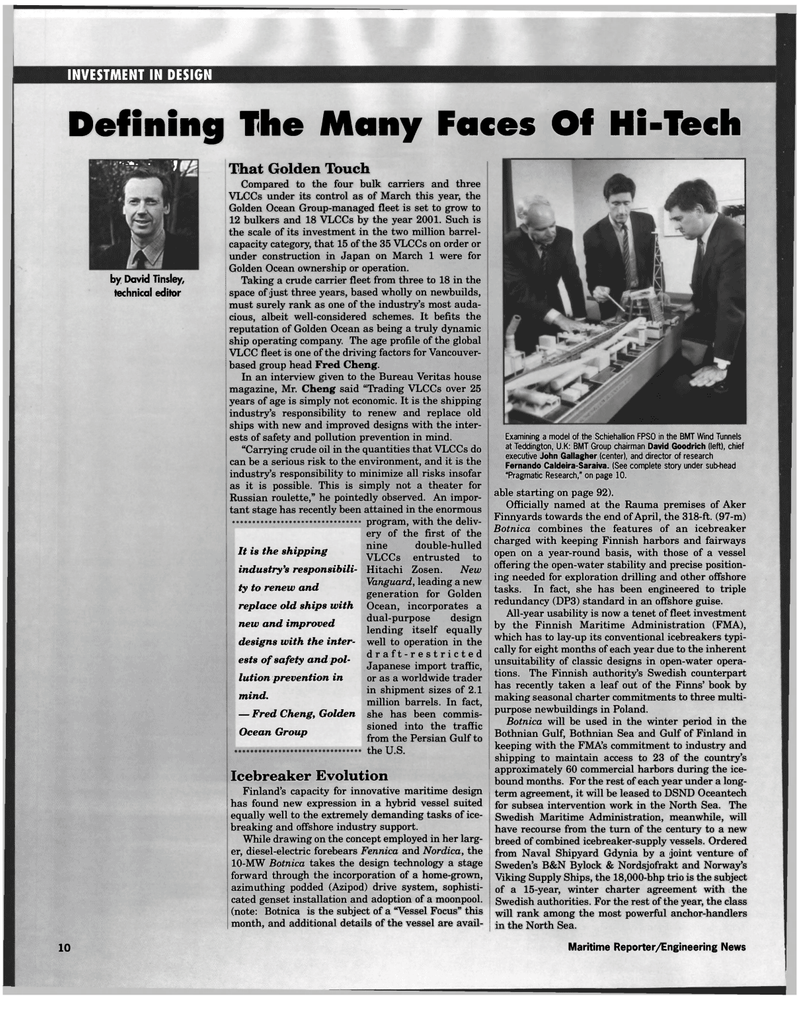
Page 10: of Maritime Reporter Magazine (June 1998)
Read this page in Pdf, Flash or Html5 edition of June 1998 Maritime Reporter Magazine
INVESTMENT IN DESIGN
Defining The Many Faces Of Hi-Tech - • j by David Tinsley, technical editor
That Golden Touch
Compared to the four bulk carriers and three
VLCCs under its control as of March this year, the
Golden Ocean Group-managed fleet is set to grow to 12 bulkers and 18 VLCCs by the year 2001. Such is the scale of its investment in the two million barrel- capacity category, that 15 of the 35 VLCCs on order or under construction in Japan on March 1 were for
Golden Ocean ownership or operation.
Taking a crude carrier fleet from three to 18 in the space of just three years, based wholly on newbuilds, must surely rank as one of the industry's most auda- cious, albeit well-considered schemes. It befits the reputation of Golden Ocean as being a truly dynamic ship operating company. The age profile of the global
VLCC fleet is one of the driving factors for Vancouver- based group head Fred Cheng.
In an interview given to the Bureau Veritas house magazine, Mr. Cheng said "Trading VLCCs over 25 years of age is simply not economic. It is the shipping industry's responsibility to renew and replace old ships with new and improved designs with the inter- ests of safety and pollution prevention in mind. "Carrying crude oil in the quantities that VLCCs do can be a serious risk to the environment, and it is the industry's responsibility to minimize all risks insofar as it is possible. This is simply not a theater for
Russian roulette," he pointedly observed. An impor- tant stage has recently been attained in the enormous program, with the deliv- ery of the first of the nine double-hulled
VLCCs entrusted to
Hitachi Zosen. New
Vanguard, leading a new generation for Golden
Ocean, incorporates a dual-purpose design lending itself equally well to operation in the draft-restricted
Japanese import traffic, or as a worldwide trader in shipment sizes of 2.1 million barrels. In fact, she has been commis- sioned into the traffic from the Persian Gulf to the U.S.
It is the shipping industry's responsibili- ty to renew and replace old ships with new and improved designs with the inter- ests of safety and pol- lution prevention in mind. — Fred Cheng, Golden
Ocean Group
Icebreaker Evolution
Finland's capacity for innovative maritime design has found new expression in a hybrid vessel suited equally well to the extremely demanding tasks of ice- breaking and offshore industry support.
While drawing on the concept employed in her larg- er, diesel-electric forebears Fennica and Nordica, the 10-MW Botnica takes the design technology a stage forward through the incorporation of a home-grown, azimuthing podded (Azipod) drive system, sophisti- cated genset installation and adoption of a moonpool. (note: Botnica is the subject of a "Vessel Focus" this month, and additional details of the vessel are avail-
Examining a model of the Schiehallion FPSO in the BMT Wind Tunnels at Teddington, U.K: BMT Group chairman David Goodrich (left), chief executive John Gallagher (center), and director of research
Fernando Caldeira-Saraiva. (See complete story under sub-head "Pragmatic Research," on page 10. able starting on page 92).
Officially named at the Rauma premises of Aker
Finnyards towards the end of April, the 318-ft. (97-m)
Botnica combines the features of an icebreaker charged with keeping Finnish harbors and fairways open on a year-round basis, with those of a vessel offering the open-water stability and precise position- ing needed for exploration drilling and other offshore tasks. In fact, she has been engineered to triple redundancy (DP3) standard in an offshore guise.
All-year usability is now a tenet of fleet investment by the Finnish Maritime Administration (FMA), which has to lay-up its conventional icebreakers typi- cally for eight months of each year due to the inherent unsuitability of classic designs in open-water opera- tions. The Finnish authority's Swedish counterpart has recently taken a leaf out of the Finns' book by making seasonal charter commitments to three multi- purpose newbuildings in Poland.
Botnica will be used in the winter period in the
Bothnian Gulf, Bothnian Sea and Gulf of Finland in keeping with the FMA's commitment to industry and shipping to maintain access to 23 of the country's approximately 60 commercial harbors during the ice- bound months. For the rest of each year under a long- term agreement, it will be leased to DSND Oceantech for subsea intervention work in the North Sea. The
Swedish Maritime Administration, meanwhile, will have recourse from the turn of the century to a new breed of combined icebreaker-supply vessels. Ordered from Naval Shipyard Gdynia by a joint venture of
Sweden's B&N Bylock & Nordsjofrakt and Norway's
Viking Supply Ships, the 18,000-bhp trio is the subject of a 15-year, winter charter agreement with the
Swedish authorities. For the rest of the year, the class will rank among the most powerful anchor-handlers in the North Sea. 10 Maritime Reporter/Engineering News

 9
9

 11
11
